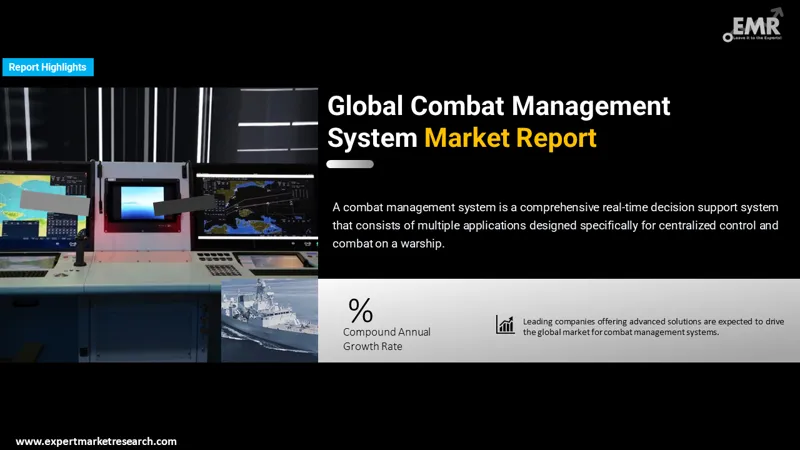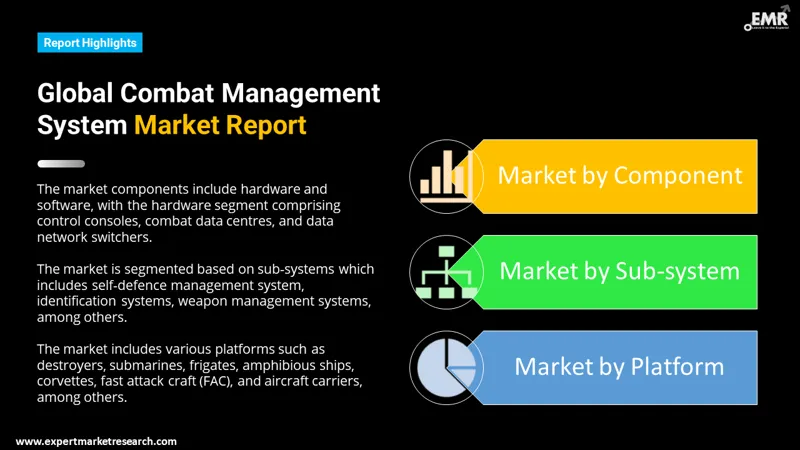
Consumer Insights
Uncover trends and behaviors shaping consumer choices today
Procurement Insights
Optimize your sourcing strategy with key market data
Industry Stats
Stay ahead with the latest trends and market analysis.
The global combat management system market is expected to grow at a CAGR of 3.70% during the period 2026-2035. Combat management system includes Sensors, EW and Communications systems. Navies today need both active and passive Electronic Support Measures (ESM), to listen to as well as counter enemy radar and communications.
Base Year
Historical Period
Forecast Period
Compound Annual Growth Rate
3.7%
2026-2035
*this image is indicative*
Warships need the capability to react to fast moving missile attack and small boat threats. Modern combat management systems assist the commander with situational awareness and safe navigation of ship. Data from sensors needs to be presented in a manner that is easily consumable and actionable. Modern sensors include both radar and electro-optical (optronics) that may assist in hazy or low light situations. Ensuring secure information and data flows is today an integral part of a modern CMS suite. North America, Europe, Latin America, and Asia are expected to be key markets.

Read more about this report - REQUEST FREE SAMPLE COPY IN PDF
A combat management system refers to a comprehensive real-time decision support system that comprises multiple applications devised particularly to perform a centralized control and combat for the warship. It is a recommendation system that utilizes surface, air and sub-surface sensors to capture information about the environment, generate a common tactical picture and determine operations to be performed according to the current scenario. Commanders today require modern combat management systems that may assist them with both situational awareness as well as safe navigation of the ship. Such need is expected to drive the global combat management system market.
A Naval Combat Management System (NCMS) refers to a software-intensive system that is sufficiently flexible to function in a multifaceted naval battle setting; it has to carry out the following key functions:
Situational Awareness - To be aware of the battle environment at sea, including surface, subsurface and air; it is collected through sensors like radars, electro–optical systems and sonar.
Intelligence – Converting data into actionable intelligence through interpretation, collation, and evaluation.
Planning and decision-making – To help commanders quickly draw an actionable plan for decision-making and implementation, in a rapidly changing and complex battle environment.
Weapon systems command and control – To direct weapon sensors and weapons to engage and destroy incoming threats.
The global combat management system market is expected to be driven by advanced solutions offered by leading companies. For example, Thales offers Tacticos, the combat management system (CMS) family. It is a single combat management system (CMS) for combat and maritime security operations. The modular combat management system is matched to multiple mission profiles and to a range of different vessel types. It enables the navies to easily establish networks in partnerships with secure Internet access, quickly recognises traffic trends and anomalous behaviour, recognises relations between contacts of interest emitting Automatic Identification System (AIS) and Automatic Dependant Surveillance-Broadcast (ADS-B), has compact and light-weight consoles that may be fitted in large and small naval vessels, and has 3D net-centric training integrated.
Saab offers 9LV CMS system that comes equipped with all the operational capability and functionality required by the ship’s Command. It is capable of meeting asymmetric threats and modern and projected future threat types. It can easily be integrated with other sub-systems like weapon systems.
Lockheed Martin offers COMBATSS-21, derived from the US Navy’s latest Aegis surface combatants. The COMBATSS-21 Combat Management System is a vital component of the Freedom-variant self-defence suite and integrates electro-optical infrared cameras, gun fire control system, radar, countermeasures and short-range anti-air missiles. COMBATSS-21 provides an adaptable, dependable next-generation defence system for the LCS. Its mission capabilities include surveillance, intelligence and reconnaissance; surface warfare; mine warfare; special operations; maritime interdiction/interception operations; anti-submarine warfare; homeland defence and anti-terrorism/force protection.

Read more about this report - REQUEST FREE SAMPLE COPY IN PDF
The EMR’s report titled “Combat Management System Market Report and Forecast 2026-2035” offers a detailed analysis of the market based on the following segments:
By component, the market is classified into:
By sub-system, the market is segmented into:
By platform, the market is divided into:
By region, the market is divided into:
The report presents a detailed analysis of the following key players in the global combat management system market, looking into their capacity, and latest developments like capacity expansions, plant turnarounds, and mergers and acquisitions:
The EMR report gives an in-depth insight into the industry by providing a SWOT analysis as well as an analysis of Porter’s Five Forces model.




*While we strive to always give you current and accurate information, the numbers depicted on the website are indicative and may differ from the actual numbers in the main report. At Expert Market Research, we aim to bring you the latest insights and trends in the market. Using our analyses and forecasts, stakeholders can understand the market dynamics, navigate challenges, and capitalize on opportunities to make data-driven strategic decisions.*
Get in touch with us for a customized solution tailored to your unique requirements and save upto 35%!
The global combat management system market is projected to grow at a CAGR of 3.70% between 2026 and 2035.
The major drivers of the market include the increasing adoption of unmanned vehicles, growing ship building activities, increasing deliveries of combat vessels, and increasing investment in the development of future-centric naval technologies.
The growing demand for advanced situational awareness systems in naval ships and submarines and increase in upgradation of legacy combat management systems by different navies are the key industry trends propelling the market's growth.
Naval combat system is an integrated combat system that combines on-board weapons and sensors into one single system; allocates missions to each weapons system based on the enemy information collected by on-board ship sensors; and carry out the engagement.
The major regions in the industry are North America, Latin America, the Middle East and Africa, Europe, and the Asia Pacific.
The components in the market are hardware and software. Hardware is further broken down into control consoles, combat data centres, and data network switchers.
Based on sub system, the market is divided into self-defence management system, identification systems, weapon management systems, track management systems, display systems, situational awareness systems, and unmanned vehicle control systems, among others.
The various platforms in the market are destroyers, submarines, frigates, amphibious ships, corvettes, fast attack craft (FAC), and aircraft carriers, among others.
The major players in the industry BAE Systems Plc., Lockheed Martin Corporation, Raytheon Technologies Corporation, Saab AB, Leonardo S.p.A., and Elbit Systems Ltd., among others.
Explore our key highlights of the report and gain a concise overview of key findings, trends, and actionable insights that will empower your strategic decisions.
| REPORT FEATURES | DETAILS |
| Base Year | 2025 |
| Historical Period | 2019-2025 |
| Forecast Period | 2026-2035 |
| Scope of the Report |
Historical and Forecast Trends, Industry Drivers and Constraints, Historical and Forecast Market Analysis by Segment:
|
| Breakup by Component |
|
| Breakup by Sub-system |
|
| Breakup by Platform |
|
| Breakup by Region |
|
| Market Dynamics |
|
| Competitive Landscape |
|
| Companies Covered |
|
| Report Price and Purchase Option | Explore our purchase options that are best suited to your resources and industry needs. |
| Delivery Format | Delivered as an attached PDF and Excel through email, with an option of receiving an editable PPT, according to the purchase option. |
Datasheet
One User
USD 2,499
USD 2,249
tax inclusive*
Single User License
One User
USD 3,999
USD 3,599
tax inclusive*
Five User License
Five User
USD 4,999
USD 4,249
tax inclusive*
Corporate License
Unlimited Users
USD 5,999
USD 5,099
tax inclusive*
*Please note that the prices mentioned below are starting prices for each bundle type. Kindly contact our team for further details.*
Flash Bundle
Small Business Bundle
Growth Bundle
Enterprise Bundle
*Please note that the prices mentioned below are starting prices for each bundle type. Kindly contact our team for further details.*
Flash Bundle
Number of Reports: 3
20%
tax inclusive*
Small Business Bundle
Number of Reports: 5
25%
tax inclusive*
Growth Bundle
Number of Reports: 8
30%
tax inclusive*
Enterprise Bundle
Number of Reports: 10
35%
tax inclusive*
How To Order

Select License Type
Choose the right license for your needs and access rights.

Click on ‘Buy Now’
Add the report to your cart with one click and proceed to register.

Select Mode of Payment
Choose a payment option for a secure checkout. You will be redirected accordingly.
Gain insights to stay ahead and seize opportunities.

Get insights & trends for a competitive edge.

Track prices with detailed trend reports.

Analyse trade data for supply chain insights.

Leverage cost reports for smart savings

Enhance supply chain with partnerships.

Connect For More Information
Our expert team of analysts will offer full support and resolve any queries regarding the report, before and after the purchase.
Our expert team of analysts will offer full support and resolve any queries regarding the report, before and after the purchase.
We employ meticulous research methods, blending advanced analytics and expert insights to deliver accurate, actionable industry intelligence, staying ahead of competitors.
Our skilled analysts offer unparalleled competitive advantage with detailed insights on current and emerging markets, ensuring your strategic edge.
We offer an in-depth yet simplified presentation of industry insights and analysis to meet your specific requirements effectively.
Share